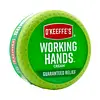What's inside
What's inside
 Key Ingredients
Key Ingredients

No key ingredients
 Benefits
Benefits

 Concerns
Concerns

 Ingredients Side-by-side
Ingredients Side-by-side

Water
Skin ConditioningGlycerin
HumectantAluminum Starch Octenylsuccinate
AbsorbentCetyl Alcohol
EmollientIsopropyl Myristate
EmollientHydrogenated Poly(C6-14 Olefin)
EmollientDimethicone
EmollientCetearyl Alcohol
EmollientButyrospermum Parkii Butter
Skin ConditioningCeteareth-20
CleansingPolyquaternium-10
Distearyldimonium Chloride
Beeswax
Emulsion StabilisingGlyceryl Stearate
EmollientPEG-100 Stearate
Laureth-4
EmulsifyingLaureth-23
CleansingPropylene Glycol
HumectantDiazolidinyl Urea
PreservativeIodopropynyl Butylcarbamate
PreservativeEthylene/Propylene/Styrene Copolymer
Butylene/Ethylene/Styrene Copolymer
Pentaerythrityl Tetra-Di-T-Butyl Hydroxyhydrocinnamate
AntioxidantDisodium EDTA
Water, Glycerin, Aluminum Starch Octenylsuccinate, Cetyl Alcohol, Isopropyl Myristate, Hydrogenated Poly(C6-14 Olefin), Dimethicone, Cetearyl Alcohol, Butyrospermum Parkii Butter, Ceteareth-20, Polyquaternium-10, Distearyldimonium Chloride, Beeswax, Glyceryl Stearate, PEG-100 Stearate, Laureth-4, Laureth-23, Propylene Glycol, Diazolidinyl Urea, Iodopropynyl Butylcarbamate, Ethylene/Propylene/Styrene Copolymer, Butylene/Ethylene/Styrene Copolymer, Pentaerythrityl Tetra-Di-T-Butyl Hydroxyhydrocinnamate, Disodium EDTA
Water
Skin ConditioningGlycerin
HumectantStearic Acid
CleansingSodium Hydroxide
BufferingParaffin
PerfumingHydroxypropyl Methylcellulose
Emulsion StabilisingAllantoin
Skin ConditioningOctyldodecyl Stearate
EmollientDiazolidinyl Urea
PreservativeIodopropynyl Butylcarbamate
PreservativeAcrylates/Acrylamide Copolymer
MoisturisingParaffinum Liquidum
EmollientPolysorbate 85
Emulsifying
 Reviews
Reviews

Ingredients Explained
These ingredients are found in both products.
Ingredients higher up in an ingredient list are typically present in a larger amount.
Diazolidinyl Urea is an antimicrobial preservative. It is commonly used to prevent bacterial, yeast, and mold growth.
Diazolidinyl Urea slowly breaks down into formaldehyde, an effective microbe killer but also a known allergen/carcinogen.
Some people who are allergic to imidazolidinyl urea also react to diazolidinyl urea. It ranked as the 14th most common allergen in patch tests from 2005–06.
Safety reviews show that at concentrations under 0.5%, the formaldehyde released remains below the accepted safety limit, making it considered safe for cosmetic use.
Ultimately, its safety depends on individual skin sensitivity and personal comfort with formaldehyde-releasing preservatives.
Learn more about Diazolidinyl UreaGlycerin is already naturally found in your skin. It helps moisturize and protect your skin.
A study from 2016 found glycerin to be more effective as a humectant than AHAs and hyaluronic acid.
As a humectant, it helps the skin stay hydrated by pulling moisture to your skin. The low molecular weight of glycerin allows it to pull moisture into the deeper layers of your skin.
Hydrated skin improves your skin barrier; Your skin barrier helps protect against irritants and bacteria.
Glycerin has also been found to have antimicrobial and antiviral properties. Due to these properties, glycerin is often used in wound and burn treatments.
In cosmetics, glycerin is usually derived from plants such as soybean or palm. However, it can also be sourced from animals, such as tallow or animal fat.
This ingredient is organic, colorless, odorless, and non-toxic.
Glycerin is the name for this ingredient in American English. British English uses Glycerol/Glycerine.
Learn more about GlycerinIodopropynyl Butylcarbamate is a preservative.
Water. It's the most common cosmetic ingredient of all. You'll usually see it at the top of ingredient lists, meaning that it makes up the largest part of the product.
So why is it so popular? Water most often acts as a solvent - this means that it helps dissolve other ingredients into the formulation.
You'll also recognize water as that liquid we all need to stay alive. If you see this, drink a glass of water. Stay hydrated!
Learn more about Water